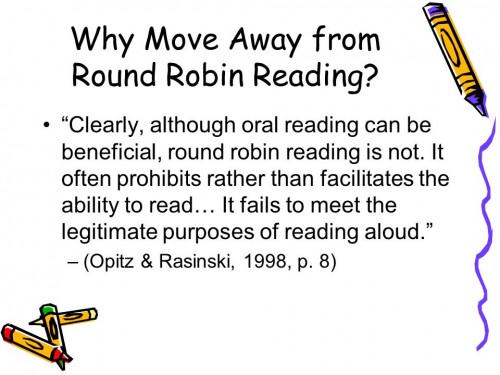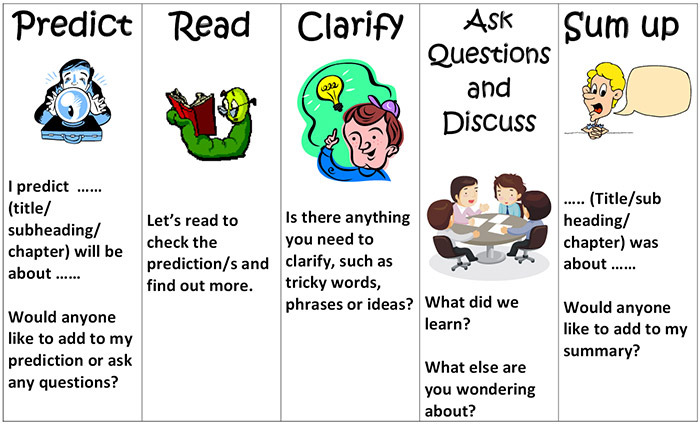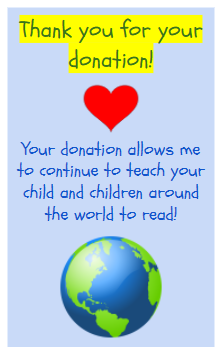What Is an Alternative to Round Robin Reading

Stop Round Robin Reading
Inquiry doesn't support round-robin or "popcorn" reading. Students actually do less reading with the round-robin or "popcorn" format. Poor readers are stigmatized, and this method lacks differentiation and slows reading rates . Information technology's an outdated exercise. P ulling names on popsicle sticks for students to read aloud must stop, likewise!
STOP Round Robin or Popcorn Reading
The following methods are flexible. You lot can use dissimilar methods during one lesson.
- Shared Reading : Teacher reads aloud, modeling fluency and expression, while students follow along in their own copy of the text . The teacher stops and models comprehension strategies.
- Choral Reading : More than one student reads at a time. The teacher may or may not choose to read with the readers. You tin can split into 'this half' and 'that half' of the reading group (or the class) to read at ane time. Fluent readers can pull along slower readers. This also has a musical quality that is very attractive to students. Students tin too echo sections as needed to build fluency and intonation.
- Echo Reading: This is wonderful for building fluency and expression. The instructor reads role of the text with enthusiasm, expression, and fluency. Students are and then asked to read that aforementioned part of the text in the same manner.
- Independent Silent Reading: Students read to a clear stopping and starting point. They read for a purpose. Follow this up with a discussion to assess comprehension. Students who finish early may answer in response journals. Beginning readers tin read into whisper phones to avoid getting distracted by others.
- Whisper Reading : Beginning readers whisper read so the teacher tin can heed in and intervene when necessary .
- Reader'south Theater: Individuals practise their parts to "perform." The Reading A-Z website has reader'due south theatre selections in many guided reading levels. Consider becoming a member! Here are free Reader'south Theatre Complimentary Scripts – Mrs. Judy Araujo, M.Ed., CAGS (mrsjudyaraujo.com).
- Teacher Cloze Reading : The teacher begins reading aloud while the students follow along. They read when the teacher drops out of the reading on important words that students demand to stress. This may include a word or two in every sentence. This method is frequently used in the intermediate grades with informational text.
- Partner Reading: This is when 2 students read using reciprocal teaching. The teacher sets a purpose, a clear starting and stopping point, and what to do when finished reading. Students "Check for Agreement" after each page by telling who/what each folio was about. To pair students, enquiry suggests listing the students in descending society of reading ability . For instance, in a class of 24, the most good reader is #1, and the one who needs the near support is #24. Split the class listing in half to have numbers 1–12 on one list and numbers thirteen–24 on another. Align the ii lists so that #1 is lined upward with #13, #ii with #14, #3 with #15, and so on until #12 matches #24. In each pair, there will not be such a bang-up difference between their proficiencies.
- Peer-Assisted Learning Strategies : These strategies are a form of partner reading. Teachers assign partners to friction match higher and lower needs students. The partners engage in a series of turns reading, rereading, and retelling. PALS focuses on three activities to support fluency and comprehension. These are partner reading, paragraph shrinking, and prediction relay. In pairs, each partner takes the atomic number 82 as Bus, alternating with the role of Reader. The reader reads aloud, and the jitney listens and provides positive feedback. The students work together to enquire questions equally they read, shrink paragraphs or summarize, and relay their predictions (following the steps of predict, read, check, and summarize) . Watch this YouTube of it: Peer Assisted Learning Strategies.
Instead of Round Robin Reading, Focus on Private Fluency
- Timed Repeated Readings : Pairs of students read an instructional level text. Students usually read passages of 50–100 words. They should each have a copy of a repeated readings chart and a pencil; each pair should share a stopwatch. First, students read the texts silently . One student then reads the passage aloud, while the other pupil times the reading and marks errors . The student should maintain advisable expression. Later 6 readings, the student records the information on a nautical chart, and the other student reads. Weekly charts can track students' growth. Teachers tin can encounter with each student to confirm the measurements.
- Peer Repeated Reading: Peer repeated readings are without stopwatches. Students read a familiar text. Once more, using a curt passage (50–100 words), the educatee pairs read the text silently . Then, taking turns, the students read the text orally 3 times. After the first reading, the pupil who is reading assesses their ain reading. After the second reading, the educatee self-assesses, and the student who is listening comments on how the reading is improving . Then the student reads a final time, cocky-assessing and listening to their partner's positive comments . The partners switch.
- Fluency-Oriented Reading Instruction :FORI is for content area teaching in the primary grades. It involves students rereading a selected text several times over the course of a calendar week. The teacher first reads aloud by the teacher, with the students post-obit along in their ain copy. Comprehension is emphasized . Over the next few days, the students echo-, choral-, and partner-read the text. Extension activities occur equally part of the literacy curriculum.
- Radio Reading : In radio reading, students are assigned parts of the text to exercise reading . After they have practiced reading their section, they develop questions to ask their peers . The post-obit solar day, the students read their section aloud, as if they are radio announcers. One time their section is finished , they may inquire their peers the questions they developed. If necessary, they may reread sections of their selection to assistance their classmates answer the questions . This is not round-robin reading because students practice their reading before they read aloud .
Instead of Round Robin Reading, Accept the Whole Class Read at One time
- Reciprocal Teaching: Suspension students into groups of iv. The purpose is to make reading techniques that skillful readers use visible to all students, to show and MODEL and DO what good readers do . Students demand to internalize that they demand to do these things in their heads with everything they read . Adept readers utilise these steps, although they are not e'er visible:
Predictor (makes and revises predictions)
Clarifier (clarifies hard points and vocabulary)
Questioner (clarifies points of doubt)
Summarizer (tells principal points, in guild)

- Reciprocal Didactics Plus: S tudents read literally , inferentially , and critically . This method is based on reciprocal teaching (Palincsar & Brown, 1984). First, the teacher models the four parts of reciprocal education. Next, the teacher moves the students towards using the 4 strategies in pairs. Students read parts of text silently , taking turns questioning, summarizing, clarifying, and predicting . Finally, Reciprocal Teaching Plus asks students to critically evaluate the text, identify the author's perspective, and analyze what points of view are omitted from the text . Prompts to employ:
Whose story is being told? What is the author'south point of view or perspective?
Is the writer taking one side or another? Does the writer tell the reader that they are doing this?
Whose story is not told? Why might that be?
What might another point of view or perspective exist?
- Crazy Professor Reading Game: Check it out hither: Crazy Professor Reading Game . This is a 4 step method.
Pace one: The students read independently with dramatic expressions. This helps them emphasize keywords and increment comprehension.
Step 2: The students use mitt gestures to add an important motor chemical element to deepen comprehension further .
Step three: The students teach their neighbor. Partners dramatically ask questions about what they've read (using paw gestures), and the other educatee answers dramatically , using paw gestures likewise . While doing this step, both students are really building their summarizing and paraphrasing abilities .
Step 4: The pairs take on roles. One is the crazy professor, who summarizes everything very dramatically . The other is the pupil who repeats eagerly what the crazy professor says.
- Jigsaw For Content Area Reading :Assign sections of reading, and divide students into dissimilar groups . Accept the whole class count off by 1, two, 3, 4. Then all the one'due south are a grouping, ii'south are a grouping. etc.) Assign each group a section of the text to read and to become an expert on. Cooperatively , the students will read and cover. Each group member becomes the expert on one section of text to teach the other groups. The teacher decides which graphic organizer is the most appropriate for each group to synthesize data to teach other groups . So, students arrive mixed groups, each with one, ii, three, and four members, and teach their section.
 A Discussion doc of this page is available with a $10 donation for my website maintenance fees. No graphics due to copyright laws. Cheers!
A Discussion doc of this page is available with a $10 donation for my website maintenance fees. No graphics due to copyright laws. Cheers!

01/18/2015
Edited on 02/24/2022
References
Edutopia
Like To Read
Copyscape alerts me to indistinguishable content. Please respect my work.
shrefflerdozziess.blogspot.com
Source: https://www.mrsjudyaraujo.com/alternatives-to-round-robin-reading/
Postar um comentário for "What Is an Alternative to Round Robin Reading"